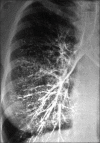Management of acquired bronchopleural fistula due to chemical pneumonia
- PMID: 29875593
- PMCID: PMC5968739
- DOI: 10.4103/tcmj.tcmj_98_17
Management of acquired bronchopleural fistula due to chemical pneumonia
Abstract
Bronchopleural fistula (BPF) is a sinus tract between the bronchus and the pleural space that may result from a necrotizing pneumonia/empyema (anaerobic, pyogenic, tuberculous, or fungal), lung neoplasms, and blunt and penetrating lung injuries or may occur as a complication of procedures such as lung biopsy, chest tube drainage, thoracocentesis, or radiation therapy. The diagnosis and management of BPF remain a major therapeutic challenge for clinicians, and the lesion is associated with significant morbidity and mortality. Here, we present a 70-year-old male with acquired BPF due to chemical pneumonitis caused by aspiration of kerosene who presented with the symptoms of fever, cough with expectoration, breathlessness and signs of tachycardia, tachypnea, diminished breath sounds, and crepitations. After a 3-week course of culture-sensitive antibiotics with β-lactam and β-lactamase inhibitors, open drainage of the empyema was done following which the patient showed symptomatic improvement and was discharged.
Keywords: Acute respiratory distress syndrome; Bronchopleural fistula; Chemical pneumonia; Contrast-enhanced computed tomography; Pleurocutaneous tract.
Conflict of interest statement
There are no conflicts of interest.
Figures




References
-
- Varoli F, Roviaro G, Grignani F, Vergani C, Maciocco M, Rebuffat C, et al. Endoscopic treatment of bronchopleural fistulas. Ann Thorac Surg. 1998;65:807–9. - PubMed
-
- Gaur P, Dunne R, Colson YL, Gill RR. Bronchopleural fistula and the role of contemporary imaging. J Thorac Cardiovasc Surg. 2014;148:341–7. - PubMed
-
- Shah N, Marwah R, Talwar I. Diagnosis of bronchopleural fistula with thin section CT scans. Bombay Hosp J. 2010;52:254–6.
-
- Vogel N, Wolcke B, Kauczor HU, Kelbel C, Mildenberger P. Detection of a bronchopleural fistula with spiral CT and 3D reconstruction. Aktuelle Radiol. 1995;5:176–8. - PubMed
-
- Peters ME, Gould HR, McCarthy TM. Identification of a bronchopleural fistula by computerized tomography – A case report. J Comput Tomogr. 1983;7:267–70. - PubMed
Publication types
LinkOut - more resources
Full Text Sources
Other Literature Sources

